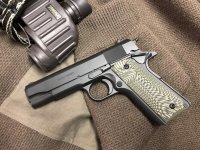My first Tisas was this one. I got the pick the one out of four that had the best combination of tightness and good trigger pull.
Darn near doubled the price by adding real red Cocobolo grips
took it to the range and I was sold after I shot this group
shoots well at 25 yards too
Every time I went to the local gunstore, I had a real hard time not buying a Tisas when they were priced $400 or less.
This is has all the features I want: tall sights, chrome barrel, GI grip safety, added an arched mainspring housing as I am getting to like the arched for one hand shooting.
I had a RIA blow a case head, because the magazine release held the round too low. The bullet was stuffed in the case during feed. That cracked the coco bolo grips on that pistol, blew the innards of the magazine, rounds included out. After that I realized that strong grips might protect my palms in an over pressure incident, and I was lucky the magazine had a plastic bottom plate and popped off easily, dropping pressures. Since then, I have been fitting 1911's with cheap Chinese ($14.00) double diamond, red laminate G10. G10 is hard and sharp, like a wood rasp, so it is real grippy, and since it is an epoxy laminate, it ought to be orders of magnitude stronger than wood.
tall rear sight with a tall and big front sight
the more recoil, the greater the flinch!
The original GI sights were developed for shooting against a black round circle on a paper target.
If you are shooting on paper, and your aimpoint is a small round circle, thin sights allow hold off against the bull if the windage/elevation is off. Remember, the sights were non adjustable. So the shooter could compensate a left shooting 1911 by holding at 5 O'C, maybe 2 O'C. Large sights, such as I prefer, you cannot pick a point because the sight is so much larger than the bull. As such, the GI sight is better for paper punching, but they are not fast acquisition sights.
One of the things I have noticed, is how firearms and sights have developed in tandem with "Combat Games". Prior to WW1, combat training was shooting on paper targets with round black circles. Sight width was based on the diameter of a round black circle on a piece of paper. But in real life, the Huns never wore on their uniforms black circles over a contrasting background. Any enemy wearing bullseye's would made excellent aimpoints for 1911 users. But it was not to be. Today, you can see so called "Tactical" pistols designed to win quick draw games, but whether the games reflect reality is different issue.
You are in his sights!
The Tisas models I own are all variations of the basic GI model, the primary variations are sights and safeties. I consider the A1 safety a better safety. They are all reliable, as accurate as I can hold off hand. I only have 45 ACP pistols and 99% of the rounds are 230 round nose bullets.
I recommend the original load used in the 1910 rounds used in the 1910 pistol test trials: a 230 FMJ with 5.0 grains Bullseye for a velocity of 800 fps. If your pistol won't shoot or function with this load, you have a stinker for a firearm.
I called Tisas about the materials in the pistols. I got two different stories, but each was a European version of 4140 steel. The original GI 1911's, the frame was SAE 1035, something almost unhardenable and similar in composition to rail road spikes. Real cheap stuff. The slide was SAE 1050, I know lawn mower blades made from 1055. Real cheap and tough. These materials are called plain carbon steels and are also very low grade. These were the absolute minimum that would go 5000 or 6000 rounds. Original 1911's were not built to last forever, those that shoot original GI 1911's find the slides crack between 10000 and 20000 rounds. However, something made out of 4140 should last orders of magnitude longer.
I do like the fact the post 2023 Tisas has all forged internal parts, pre 2023 internal parts were MIM, and the forged slide and receiver are hardened then machined. GI 1911's only had the slide nose hardened for two inches, to keep the nose from being knocked off under recoil. I do believe the Tisas slide is only "slightly" hardened as you don't really need knife blade level hardness in this application. Hardness and toughness work against each other. This pistol functions with an impact load, and toughness gives a longer fatigue life than does hardness. All you need to do is harden the steel so it holds up to the pressures of combustion, and keep what toughness you can to allow for a greater fatigue lifetime. A forged 4140 part should not have voids, and the material is just vastly better in all respects to the plain carbon steels used in the GI 1911's. One data point, the Charpy impact energy required to shear 4140 at minus 40 F is probably four times greater than plain carbon steels. Alloys have come a long way since 1900.
















